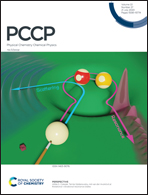Components of the interaction energy of the odd-electron halogen bond: an ab initio study†
Abstract
In the realm of non-covalent interactions (NCI), the odd-electron halogen bond offers a fertile ground to explore the nature of such weak interactions. Here, an ab initio study of odd-electron halogen bonding (XB) is reported. The interactions of five radicals with several freons and interhalogens are studied using the Møller–Plesset (MP2) method. The regioselectivity, interaction energy and the components of the interaction energy of odd-electron XB were tuned by judicial selection of donor–acceptor pairs as revealed by scrutinizing the conceptual DFT parameters, NCI plot and LED-DLPNO-CCSD(T) analysis. The contribution from dispersion interaction is rather high for all XB bonded complexes and it increases when the interacting atom of the XB donor is highly polarizable. Additionally, the polarisation and intermolecular charge-transfer also contribute significantly when both the donor and acceptor atoms are soft species, resulting in a soft–soft interaction. We believe that our finding will not only shed new light on non-covalent interaction of odd-electron XB but will also be able to capture the pnictogen, chalcogen and tetrel bonding interactions. The ability of conceptual DFT parameters to predict the interaction energy and its components shown in this study will be helpful for tuning of substrates for desired products, modelling bio/macromolecules and crystal engineering.



 Please wait while we load your content...
Please wait while we load your content...